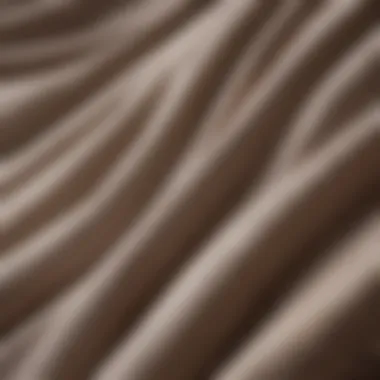Understanding Thread Count and Fabric Softness


Intro
In the world of textiles, the terms "thread count" and "softness" often come up in discussions about fabric quality. Thread count generally refers to the number of threads woven together in one square inch of fabric. A higher number typically suggests a finer, denser fabric. However, this is not the complete story. Softness is not determined solely by thread count; it is influenced by the material used, the weaving technique, and individual preferences. As homeowners and fabric enthusiasts seek the best textiles for their personal spaces, understanding these concepts becomes essential.
Various materials like cotton, linen, silk, and synthetic fibers each present different characteristics. For example, Egyptian cotton is praised for its long fibers, promoting a softer texture, while polyester can feel less luxurious despite a high thread count. This article will delve deeper into these characteristics, elucidating how they affect perceived softness and overall comfort.
Furthermore, the choice of fabric has significant implications in home decor. Selecting the right materials not only enhances comfort but also influences the aesthetic of interior spaces. Therefore, this guide aims to equip readers with the knowledge necessary to make informed decisions, whether they are purchasing bed linens, tablecloths, or decorative pillows.
In this journey through the intricacies of thread count and fabric softness, we aim to clarify misconceptions and highlight the importance of quality over mere numerical superiority. To assist you further, we will also provide practical tips on selecting the right fabric types for different needs.
Prelims to Thread Count
Thread count often serves as an important metric when discussing fabric softness and overall quality. A higher thread count is frequently equated with superior comfort and a more luxurious feel. However, this assumption can be misleading. Understanding thread count requires a deeper consideration of how it is defined and measured.
Definition of Thread Count
Thread count refers to the number of horizontal and vertical threads woven into one square inch of fabric. It includes both the warp (vertical) and weft (horizontal) threads, which come together to form the fabric's structure. While common belief suggests that a higher thread count always results in softer fabric, this is not entirely accurate. The type of material, its weave, and finishing processes also play significant roles in the quality and tactile experience of the fabric.
The Measurement Process
Measuring thread count is a straightforward process, but ensuring accuracy requires precision. The number is typically calculated by counting the threads in a one-inch square. Manufacturers may use various techniques that can somewhat inflate these numbers, leading to potential confusion for consumers. It's essential to be aware of potential misrepresentations.
For an accurate assessment:
- Lay the fabric flat on a hard surface.
- Use a ruler to determine one square inch.
- Count all threads that run both horizontally and vertically within that area.
The resulting figure gives the basic thread count. It is worth noting that two extreme cases can occur:
- Low thread counts may result in coarse and rough fabrics.
- Very high thread counts do not guarantee enhanced softness, as they can sometimes involve inferior threading techniques or lower-quality materials.
"A higher thread count does not always equate to better quality; fabric type and weaving methods are equally vital."
In summary, the introduction of thread count sets the stage for understanding fabric softness. While it can provide valuable insight into the fabric's potential for comfort, it is only one aspect of a larger picture that includes material quality, weave patterns, and finishing techniques.
Softness: A Subjective Experience
Softness is not simply a characteristic of fabric; it is a nuanced and personal experience shaped by various factors. Understanding this subjective nature is crucial in the context of selecting linens and textiles. What is soft for one individual may not feel the same to another, revealing the intricacies in how we perceive fabric.
Softness can enhance comfort, especially in items we frequently use, such as bed sheets, towels, and clothing. This experience influences our choices, often leading us to prioritize fabrics that feel pleasant against our skin. However, while the desire for softness is universal, how we define and recognize it can vary significantly among individuals.
This section invites readers to explore the multifaceted nature of softness, encouraging consideration of personal preferences and sensitivities. By recognizing these differences, homeowners, interior design enthusiasts, and party hosts can make more informed decisions when selecting textiles that match their comfort standards.
Understanding Softness
Softness in fabric can be described as the pleasant tactile feel that it imparts when touched. However, this definition is too simplistic. The sensation of softness depends on several interconnected elements. For instance, the structure of the fibers, the weave of the fabric, and even the finish applied can all contribute to how soft a fabric feels.
Moreover, factors such as wear and washing can significantly alter a fabric's softness over time. For example, cotton may initially feel crisp but become exceptionally soft after several washes because of fiber relaxation.
Furthermore, individuals may have distinct sensitivities that affect their perception of softness. A fabric that feels soft to one person might cause irritation for someone else. This variance highlights the importance of individual experiences when assessing fabric quality.
Factors Influencing Fabric Softness
Several aspects play a role in how softness is perceived:
- Fiber Type: Different materials inherently possess unique textures. Cotton tends to feel soft and breathable, while silk offers a luxurious smoothness.
- Yarn Structure: The twist and thickness of yarns used in weaving can affect the overall softness. Looser weaves often yield softer fabrics.
- Weaving Technique: The method of weaving can play a significant role. For example, sateen weaving produces a denser and smoother finish compared to percale.
- Finishing Processes: Treatments applied to fabrics after weaving can enhance or diminish softness. Some fabrics undergo softening agents, while others are starched for a crisper feel.
- Environmental Factors: Conditions such as humidity and temperature can also influence the thermal properties of fabrics, thereby affecting perceived softness.


"The experience of softness is not just a physical characteristic; it is a complex interplay of personal sensations, environmental conditions, and material properties."
Understanding these factors provides a strong foundation for discerning quality fabrics. By acknowledging how softness varies between fabrics and how personal preferences shape perceptions, consumers can more accurately choose textiles that enhance their comfort and satisfaction.
Exploring Fabric Types
When examining the intricacies of thread count and softness, understanding fabric types becomes essential. Each material carries unique characteristics that influence not only its tactile experience but also its durability and overall appeal. Homeowners and design enthusiasts alike should consider how fabric choices can enhance comfort and style in various settings.
Cotton: The Classic Choice
Cotton is often seen as the gold standard when it comes to soft textiles. Its natural fibers offer breathability, making it a popular choice for bedding, clothing, and home accessories. The softness of cotton can vary widely depending on the type, weave, and treatment.
- Varieties Include: Egyptian, Pima, and Upland cotton.
- Benefits: It holds color well and is usually easy to care for, maintaining its softness wash after wash.
- Considerations: While it is generally soft, the thread count can also influence the comfort level. Higher thread counts often translate to a smoother finish.
Silk: Luxurious but Fragile
Silk is synonymous with luxury and elegance. Its smooth texture makes it incredibly soft against the skin, providing a unique sensation unmatched by many other fabrics. However, this softness comes with a few trade-offs.
- Care Requirements: It is more delicate than cotton and should be handled with care to prevent damage.
- Temperature Regulation: Silk has natural insulating properties, keeping you warm in winter yet cool in the summer.
- Considerations: While a high thread count can enhance silk's luxurious feel, it is essential to balance it with durability in mind.
Linen: Breathable and Textured
Linen is an exceptional choice for warmer climates. Its natural fibers create a breathable fabric that offers comfort, especially during hot weather. The texture has a distinct feel that contributes to its charm.
- Durability: Linen is strong and can withstand significant wear, becoming softer with every wash.
- Benefits: It is resistant to mildew and has hypoallergenic properties, making it suitable for sensitive skin.
- Considerations: While linen is known for its texture and comfort, it may not drape as smoothly as silk or cotton, which can affect its appearance in home décor.
Microfiber: Modern Innovation
Microfiber has become increasingly popular in recent years due to its versatility and innovative properties. Made from synthetic fibers, this fabric is engineered to be soft and durable.
- Performance: Microfiber is often used in cleaning products, modern upholstery, and bedding because of its ability to repel stains and resist fading.
- Softness: It can achieve a higher softness level at lower thread counts compared to natural fibers. This is due to the finer strands of the fibers themselves.
- Considerations: While it offers easy maintenance and comfort, some may prefer the feel of natural fabrics against their skin.
Understanding the different fabric types is crucial in selecting the right one for your needs. Each type carries its own set of properties that will contribute to overall comfort and durability in textiles.
The Science Behind Softness and Thread Count
Understanding the science behind softness and thread count is essential for anyone delving into the realm of textiles. This aspect bridges the technical specifics of fabric construction with the subjective experience of touch. Awareness of how thread count influences softness can substantially enhance decision-making when selecting sheets, pillowcases, or any other linen.
The interplay between thread count and softness is not merely academic; it has real consequences for comfort and usability. As thread counts increase, the density of threads per square inch affects how the fabric feels against the skin. However, this relationship is shaped by various factors beyond numbers alone.
For the informed consumer, understanding this science aids in establishing a clear basis for distinguishing between different fabrics.
How Thread Count Affects Softness
Thread count refers to the number of horizontal and vertical threads woven together in a square inch of fabric. It is widely assumed that a higher thread count results in superior softness. While this is often the case, it oversimplifies a complex reality. Increasing the thread count can lead to denser fabric, which may enhance smoothness, but also can create a fabric that feels less breathable.
Sometimes, a high thread count does not translate into actual softness due to the thread quality and the weave itself.
- Material Quality: It is also important to recognize that higher-quality cotton or silk, even at a lower thread count, can outperform lower-quality options with higher thread counts.
- Fabric Weave: Different weaves, such as percale or sateen, can dramatically alter how soft a fabric feels regardless of thread count. For instance, sateen weaving can lend a silkier texture to the fabric compared to percale, which offers a crisper feel.
High vs. Low Thread Count
When evaluating high versus low thread counts, several important factors arise:
- High Thread Count: Fabrics boasting high thread counts, typically over 600, may feel luxurious initially. However, they may lack durability or breathability in prolonged use. Furthermore, such high figures can be misleading, as manufacturers may inflate counts through the use of multi-ply threads.
- Low Thread Count: Conversely, lower thread counts, such as those under 200, often result in a less smooth feel. However, these fabrics can offer excellent breathability and comfort, particularly during warmer weather.


"Quality of material and construction techniques often has a more significant impact on comfort than thread count alone."
Both high and low thread counts have their applications, and the ultimate choice depends on individual comfort preferences and specific use cases. Understanding the distinction between these options enables consumers to make informed choices, avoiding common pitfalls and misconceptions about thread count and softness in fabrics.
Quality Versus Quantity
The distinction between quality and quantity in fabrics is a nuanced yet critical aspect of understanding textiles. While thread count often takes center stage in consumer discussions regarding fabric softness, focusing solely on this metric can lead to misunderstandings. The importance of quality cannot be overstated when it comes to the overall feel, durability, and functionality of textiles.
Assessing Quality in Fabrics
Quality can be assessed through various dimensions. First, look into the fiber origin. Natural fibers such as Egyptian cotton or Peruvian pima cotton are known for their superior softness and longevity compared to regular cotton. Synthetic fibers, although high in thread count, may lack the breathability and comfort afforded by quality natural fibers.
Second, evaluate the weave type. Common weaves include percale, sateen, and twill; each offers different experiences. Sateen, for instance, can feel softer due to its smooth texture, but may not be as durable as a twill weave. Additionally, check for any finishing processes. Fabrics that undergo chemical treatments for added softness may be susceptible to wear over time.
In essence, assessing quality means going beyond just a number and understanding the fabric's entire makeup. Paying attention to these aspects ensures not just better comfort, but also a longer-lasting product.
Importance of Material Composition
The material composition of fabrics plays a pivotal role in how they feel against the skin and their overall performance. Each fabric type possesses unique properties dictated by its fibers. Natural fibers like cotton and linen are breathable and ideal for warmer climates, benefiting individuals who prioritize air circulation. In contrast, synthetic fibers, such as polyester, offer resilience and are often stain-resistant but might trap heat.
When selecting fabric, considering a blend of fabrics may also enhance functionality. For instance, a cotton-polyester blend can combine the softness of cotton with the durability of polyester, thus creating a more practical choice for everyday use.
Moreover, the decision made at this stage influences future care processes. Different materials require varying maintenance. Understanding these factors not only contributes to immediate softness but affects long-term satisfaction with the product. In a pursuit of comfort, considering material composition proves to be essential.
Popular Misconceptions about Thread Count
Both consumers and industry professionals frequently harbor misconceptions regarding thread count and its impact on fabric softness. This section will clarify these misunderstandings. Misconceptions can lead to poor buying decisions that do not align with personal preferences or needs. Thus, addressing these myths is essential for making informed choices in textiles.
Debunking the Myths
One prevalent myth is that a higher thread count always ensures a softer and better-quality fabric. While it is true that generally, higher thread counts can produce softer textiles, this is not an absolute rule. For instance, a cotton fabric with a 400 thread count may feel softer than a 600 thread count polyester blend.
Another misconception is that thread count is solely about the number of threads per square inch. In fact, the method of weaving and the type of fibers contribute significantly to the overall feel of the fabric. Additionally, some manufacturers inflate thread count numbers by counting multiple plies of thread, which can mislead consumers. Thus, it is essential to understand the context of thread count, including the material's overall construction and weave pattern.
"Not all thread counts are created equal; quality often trumps quantity."
Consumer frustration can arise from these misunderstandings, leading them to purchase fabric that does not meet their expectations. Consumers must carefully evaluate product labels. Searching for more than just thread count can lead to better decisions.
Consumer Misguidance
Another significant issue arises from marketing practices that focus heavily on thread count, misleading consumers to believe it without any additional context. This focus distracts buyers from the material quality and construction. For example, luxury sheets may advertise a high thread count, but without high-quality cotton or an excellent weave, the softness may not be consistent.
Consumers should take time to understand what materials and weaves give the best results for their needs. Not all cotton is the same; Egyptian cotton, for example, is known for its long fibers and durability compared to standard cotton varieties.
Moreover, it's beneficial to engage with reviews and expert advice. Reading about the product’s performance from others provides deeper insights than counting threads. The conversation around quality versus quantity continues to grow in importance within fabric choices, especially as awareness increases.
Personal Preferences and Comfort Levels
The choice of fabric is often influenced by personal preferences and comfort levels. Each person's body reacts differently to various types of textiles. These reactions are driven by individual sensitivities and cultural backgrounds. Understanding this can play a vital role in selecting the right linens for any setting.
Individual Sensitivities
People have unique skin sensitivities that directly affect their comfort with various fabrics. Some may find certain materials, such as wool or synthetic fibers, irritating to their skin. Others might experience discomfort with high-thread-count cotton due to its dense weave, which can trap heat and moisture. It is essential to recognize that not every high thread count translates to softness or comfort for every individual. Factors such as allergies to specific materials or skin conditions can significantly influence choices.
"Not all fabrics are created equal; individual reactions can vary widely based on personal sensitivities."


When selecting linens, it can be beneficial to try samples before making a final purchase, especially for bed sheets or clothing items. Buying fabric swatches allows individuals to test for comfort before committing to larger investments. Ultimately, comfort comes from recognizing individual needs and adapting choices accordingly.
Cultural Influences on Softness Perception
Cultural differences play an essential role in how individuals perceive softness in fabric. For instance, in Western cultures, materials like Egyptian cotton and silk are often considered the pinnacle of softness and luxury. In contrast, some Eastern cultures might prefer natural fibers such as linen or bamboo, valuing temperature regulation over the sensation of softness.
These preferences can be influenced by various factors:
- Climate: Humid regions may favor breathable fabrics, while cooler areas might opt for thicker textiles for warmth.
- Tradition: Handwoven fabrics often carry cultural significance, which may override modern standards of softness.
- Usage: The intended use of the fabric, such as for everyday wear or special occasions, can shape preferences and perceptions about what is soft enough.
Being open to diverse perspectives can enhance one's experience in selecting comfortable fabrics. Engaging with different cultural practices can lead to greater appreciation for various materials. As we navigate our choices, it is crucial to understand not just what feels soft, but what represents comfort within our unique contexts.
Selecting Linens for Different Uses
Selecting the right linens for various purposes is crucial. Each type of linen serves a distinct function and should be chosen carefully to ensure that it meets both aesthetic and practical needs. Understanding the nuances involved in this selection process allows buyers to maximize their investment and enjoyment of these textiles. In this section, we will explore the considerations necessary for choosing linens for bedding, table settings, and home accessories.
Bed Sheets: Prioritizing Comfort
When it comes to bed sheets, comfort is the paramount concern. Softness and the feel against the skin directly affect sleep quality. A higher thread count generally contributes to a smoother texture, but it is essential to consider the material type. Options like Egyptian cotton or Tencel offer distinct benefits. Egyptian cotton is renowned for its long, silky fibers, which promote softness and breathability. Tencel, on the other hand, is often praised for its moisture-wicking abilities.
Opting for a thread count of at least 300 can enhance comfort significantly. However, keep in mind that personal preference plays a large role. Some may prefer the crisp feel of percale, while others may find sateen more luxurious.
"The right bed sheet can transform your sleep experience, influencing everything from comfort to temperature regulation."
Table Linens: Function vs. Style
In a dining context, table linens strike a delicate balance between function and aesthetic appeal. The choice of tablecloth, napkins, and placemats must consider the occasion. For everyday use, materials like cotton are practical and can withstand frequent washing. Higher-end fabrics such as linen or silk infuse elegance into special gatherings.
When selecting table linens, consider how they complement dinnerware and the overall theme of the event. Here are some practical tips:
- Choose colors and patterns that enhance the table setting.
- Assess the fabric’s ability to repel stains, especially for casual dining.
- Ensure that the size of the linens is appropriate for the table dimensions.
Home Accessories: Balancing Softness and Durability
Home accessories, including throw pillows and blankets, should strike a balance between softness and durability. Items in high-traffic areas or frequently used spaces must withstand wear while still providing comfort. Fabrics such as acrylic blends offer resilience along with a soft touch, making them suitable for active households.
When selecting these accessories, take into account:
- The fabric’s cleaning requirements.
- How well it maintains its appearance after use.
- The overall feel in relation to other furnishings.
In summary, each linen type serves specific functions that impact overall comfort and style. Taking time to evaluate material properties and personal preferences can lead to better selections. Readers and consumers should consider these factors seriously to enhance their living spaces and experiences.
Final Thoughts on Thread Count and Softness
Understanding the relationship between thread count and softness in fabric is pivotal for making informed decisions when selecting linens and textiles. This concluding section synthesizes the key insights provided throughout the article. It emphasizes how thread count should not be the sole indicator of quality. While higher thread counts can suggest a greater number of threads woven together, they do not necessarily correlate with softness. Softness is influenced by several factors, including material type, weave patterns, and finishes applied to the fabric.
Another important element to consider is personal preference. Different individuals have varying definitions of softness, impacting their choices when it comes to fabrics for bedding, table linens, or home accessories. This highlights the necessity for consumers to engage in the tactile experience offered by different fabrics.
Summary of Key Points
- Thread Count vs. Softness: Higher thread count does not always mean softer fabric.
- Deciding Factors of Softness: Material type and weave pattern can significantly influence how a fabric feels.
- Personal Preference: Individual sensitivities and cultural perceptions shape perceptions of softness.
- Quality Over Quantity: Prioritizing fabric quality over thread count assures better comfort.
Encouraging Informed Choices
Making well-informed choices about fabrics is essential for both comfort and functionality. Homeowners and design enthusiasts should not hesitate to explore various textiles. Consider trying out multiple options in-store or requesting samples before making a commitment.
Here are some reminders to consider when choosing linens:
- Pay attention to material composition as it affects the overall feel.
- Explore different weave patterns and their respective comfort levels.
- Compare the finishing treatments that can enhance softness without increasing thread count.
In doing so, one can ensure that the textiles selected align with personal comfort preferences while fulfilling aesthetic and functional requirements.
"Investing time in understanding fabrics pays off in creating a comfortable and inviting home."



